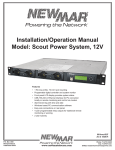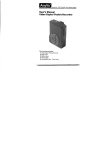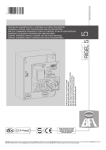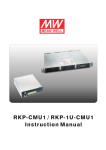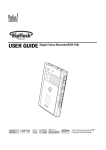Download LCD TV SERVICE MANUAL
Transcript
Internal Use Only website:http://biz.LGservice.com LCD TV SERVICE MANUAL CHASSIS : LP7BB MODEL : 32LB9RTA/B/E MODEL : 32LB9RTA/B/E-MB CAUTION BEFORE SERVICING THE CHASSIS, READ THE SAFETY PRECAUTIONS IN THIS MANUAL. CONTENTS CONTENTS .............................................................................................. 2 SAFETY PRECAUTIONS ..........................................................................3 SPECIFICATION ........................................................................................6 ADJUSTMENT INSTRUCTION ...............................................................10 TROUBLE SHOOTING ............................................................................14 BLOCK DIAGRAM...................................................................................25 EXPLODED VIEW .................................................................................. 26 EXPLODED VIEW PARTS LIST ..............................................................27 REPLACEMENT PARTS LIST ............................................................... 28 SVC. SHEET ............................................................................................... Copyright © 2007 LG Electronics. Inc. All right reserved. Only for training and service purposes -2- LGE Internal Use Only SAFETY PRECAUTIONS IMPORTANT SAFETY NOTICE Many electrical and mechanical parts in this chassis have special safety-related characteristics. These parts are identified by in the Schematic Diagram and Replacement Parts List. It is essential that these special safety parts should be replaced with the same components as recommended in this manual to prevent Shock, Fire, or other Hazards. Do not modify the original design without permission of manufacturer. Leakage Current Hot Check (See below Figure) Plug the AC cord directly into the AC outlet. General Guidance An isolation Transformer should always be used during the servicing of a receiver whose chassis is not isolated from the AC power line. Use a transformer of adequate power rating as this protects the technician from accidents resulting in personal injury from electrical shocks. It will also protect the receiver and it's components from being damaged by accidental shorts of the circuitry that may be inadvertently introduced during the service operation. If any fuse (or Fusible Resistor) in this TV receiver is blown, replace it with the specified. When replacing a high wattage resistor (Oxide Metal Film Resistor, over 1W), keep the resistor 10mm away from PCB. Do not use a line Isolation Transformer during this check. Connect 1.5K/10watt resistor in parallel with a 0.15uF capacitor between a known good earth ground (Water Pipe, Conduit, etc.) and the exposed metallic parts. Measure the AC voltage across the resistor using AC voltmeter with 1000 ohms/volt or more sensitivity. Reverse plug the AC cord into the AC outlet and repeat AC voltage measurements for each exposed metallic part. Any voltage measured must not exceed 0.75 volt RMS which is corresponds to 0.5mA. In case any measurement is out of the limits specified, there is possibility of shock hazard and the set must be checked and repaired before it is returned to the customer. Leakage Current Hot Check circuit Keep wires away from high voltage or high temperature parts. AC Volt-meter Before returning the receiver to the customer, always perform an AC leakage current check on the exposed metallic parts of the cabinet, such as antennas, terminals, etc., to be sure the set is safe to operate without damage of electrical shock. Leakage Current Cold Check(Antenna Cold Check) With the instrument AC plug removed from AC source, connect an electrical jumper across the two AC plug prongs. Place the AC switch in the on position, connect one lead of ohm-meter to the AC plug prongs tied together and touch other ohm-meter lead in turn to each exposed metallic parts such as antenna terminals, phone jacks, etc. If the exposed metallic part has a return path to the chassis, the measured resistance should be between 1MΩ and 5.2MΩ. When the exposed metal has no return path to the chassis the reading must be infinite. An other abnormality exists that must be corrected before the receiver is returned to the customer. To Instrument's exposed METALLIC PARTS Good Earth Ground such as WATER PIPE, CONDUIT etc. 0.15uF 1.5 Kohm/10W Replaceable batteries CAUTION RISK OF EXPLOSION IF BATTERY IS REPLACED BY AN INCORRECT TYPE. DISPOSE OF USED BATTERIES ACCORDING TO THE INSTRUCTIONS ADVARSEL Lithiumbatteri - Eksplosionsfare ved fejlagtig hándtening. Udskiftning má kun ske med batteri at samme fabrikat og type. Levér det brugte batteri tilbage til leverandoren Copyright © 2007 LG Electronics. Inc. All right reserved. Only for training and service purposes -3- LGE Internal Use Only SERVICING PRECAUTIONS CAUTION: Before servicing receivers covered by this service manual and its supplements and addenda, read and follow the SAFETY PRECAUTIONS on page 3 of this publication. NOTE: If unforeseen circumstances create conflict between the following servicing precautions and any of the safety precautions on page 3 of this publication, always follow the safety precautions. Remember: Safety First. General Servicing Precautions 1. Always unplug the receiver AC power cord from the AC power source before; a. Removing or reinstalling any component, circuit board module or any other receiver assembly. b. Disconnecting or reconnecting any receiver electrical plug or other electrical connection. c. Connecting a test substitute in parallel with an electrolytic capacitor in the receiver. CAUTION: A wrong part substitution or incorrect polarity installation of electrolytic capacitors may result in an explosion hazard. 2. Test high voltage only by measuring it with an appropriate high voltage meter or other voltage measuring device (DVM, FETVOM, etc) equipped with a suitable high voltage probe. Do not test high voltage by "drawing an arc". 3. Do not spray chemicals on or near this receiver or any of its assemblies. 4. Unless specified otherwise in this service manual, clean electrical contacts only by applying the following mixture to the contacts with a pipe cleaner, cotton-tipped stick or comparable non-abrasive applicator; 10% (by volume) Acetone and 90% (by volume) isopropyl alcohol (90%-99% strength) CAUTION: This is a flammable mixture. Unless specified otherwise in this service manual, lubrication of contacts in not required. 5. Do not defeat any plug/socket B+ voltage interlocks with which receivers covered by this service manual might be equipped. 6. Do not apply AC power to this instrument and/or any of its electrical assemblies unless all solid-state device heat sinks are correctly installed. 7. Always connect the test receiver ground lead to the receiver chassis ground before connecting the test receiver positive lead. Always remove the test receiver ground lead last. 8. Use with this receiver only the test fixtures specified in this service manual. CAUTION: Do not connect the test fixture ground strap to any heat sink in this receiver. Electrostatically Sensitive (ES) Devices Some semiconductor (solid-state) devices can be damaged easily by static electricity. Such components commonly are called Electrostatically Sensitive (ES) Devices. Examples of typical ES devices are integrated circuits and some field-effect transistors and semiconductor "chip" components. The following techniques should be used to help reduce the incidence of component damage caused by static by static electricity. 1. Immediately before handling any semiconductor component or semiconductor-equipped assembly, drain off any electrostatic charge on your body by touching a known earth ground. Alternatively, obtain and wear a commercially available discharging wrist strap device, which should be removed to prevent potential shock reasons prior to applying power to the Copyright © 2007 LG Electronics. Inc. All right reserved. Only for training and service purposes unit under test. 2. After removing an electrical assembly equipped with ES devices, place the assembly on a conductive surface such as aluminum foil, to prevent electrostatic charge buildup or exposure of the assembly. 3. Use only a grounded-tip soldering iron to solder or unsolder ES devices. 4. Use only an anti-static type solder removal device. Some solder removal devices not classified as "anti-static" can generate electrical charges sufficient to damage ES devices. 5. Do not use freon-propelled chemicals. These can generate electrical charges sufficient to damage ES devices. 6. Do not remove a replacement ES device from its protective package until immediately before you are ready to install it. (Most replacement ES devices are packaged with leads electrically shorted together by conductive foam, aluminum foil or comparable conductive material). 7. Immediately before removing the protective material from the leads of a replacement ES device, touch the protective material to the chassis or circuit assembly into which the device will be installed. CAUTION: Be sure no power is applied to the chassis or circuit, and observe all other safety precautions. 8. Minimize bodily motions when handling unpackaged replacement ES devices. (Otherwise harmless motion such as the brushing together of your clothes fabric or the lifting of your foot from a carpeted floor can generate static electricity sufficient to damage an ES device.) General Soldering Guidelines 1. Use a grounded-tip, low-wattage soldering iron and appropriate tip size and shape that will maintain tip temperature within the range or 500°F to 600°F. 2. Use an appropriate gauge of RMA resin-core solder composed of 60 parts tin/40 parts lead. 3. Keep the soldering iron tip clean and well tinned. 4. Thoroughly clean the surfaces to be soldered. Use a mall wirebristle (0.5 inch, or 1.25cm) brush with a metal handle. Do not use freon-propelled spray-on cleaners. 5. Use the following unsoldering technique a. Allow the soldering iron tip to reach normal temperature. (500°F to 600°F) b. Heat the component lead until the solder melts. c. Quickly draw the melted solder with an anti-static, suctiontype solder removal device or with solder braid. CAUTION: Work quickly to avoid overheating the circuit board printed foil. 6. Use the following soldering technique. a. Allow the soldering iron tip to reach a normal temperature (500°F to 600°F) b. First, hold the soldering iron tip and solder the strand against the component lead until the solder melts. c. Quickly move the soldering iron tip to the junction of the component lead and the printed circuit foil, and hold it there only until the solder flows onto and around both the component lead and the foil. CAUTION: Work quickly to avoid overheating the circuit board printed foil. d. Closely inspect the solder area and remove any excess or splashed solder with a small wire-bristle brush. -4- LGE Internal Use Only IC Remove/Replacement Some chassis circuit boards have slotted holes (oblong) through which the IC leads are inserted and then bent flat against the circuit foil. When holes are the slotted type, the following technique should be used to remove and replace the IC. When working with boards using the familiar round hole, use the standard technique as outlined in paragraphs 5 and 6 above. Removal 1. Desolder and straighten each IC lead in one operation by gently prying up on the lead with the soldering iron tip as the solder melts. 2. Draw away the melted solder with an anti-static suction-type solder removal device (or with solder braid) before removing the IC. Replacement 1. Carefully insert the replacement IC in the circuit board. 2. Carefully bend each IC lead against the circuit foil pad and solder it. 3. Clean the soldered areas with a small wire-bristle brush. (It is not necessary to reapply acrylic coating to the areas). "Small-Signal" Discrete Transistor Removal/Replacement 1. Remove the defective transistor by clipping its leads as close as possible to the component body. 2. Bend into a "U" shape the end of each of three leads remaining on the circuit board. 3. Bend into a "U" shape the replacement transistor leads. 4. Connect the replacement transistor leads to the corresponding leads extending from the circuit board and crimp the "U" with long nose pliers to insure metal to metal contact then solder each connection. Power Output, Transistor Device Removal/Replacement 1. Heat and remove all solder from around the transistor leads. 2. Remove the heat sink mounting screw (if so equipped). 3. Carefully remove the transistor from the heat sink of the circuit board. 4. Insert new transistor in the circuit board. 5. Solder each transistor lead, and clip off excess lead. 6. Replace heat sink. Circuit Board Foil Repair Excessive heat applied to the copper foil of any printed circuit board will weaken the adhesive that bonds the foil to the circuit board causing the foil to separate from or "lift-off" the board. The following guidelines and procedures should be followed whenever this condition is encountered. At IC Connections To repair a defective copper pattern at IC connections use the following procedure to install a jumper wire on the copper pattern side of the circuit board. (Use this technique only on IC connections). 1. Carefully remove the damaged copper pattern with a sharp knife. (Remove only as much copper as absolutely necessary). 2. carefully scratch away the solder resist and acrylic coating (if used) from the end of the remaining copper pattern. 3. Bend a small "U" in one end of a small gauge jumper wire and carefully crimp it around the IC pin. Solder the IC connection. 4. Route the jumper wire along the path of the out-away copper pattern and let it overlap the previously scraped end of the good copper pattern. Solder the overlapped area and clip off any excess jumper wire. At Other Connections Use the following technique to repair the defective copper pattern at connections other than IC Pins. This technique involves the installation of a jumper wire on the component side of the circuit board. 1. Remove the defective copper pattern with a sharp knife. Remove at least 1/4 inch of copper, to ensure that a hazardous condition will not exist if the jumper wire opens. 2. Trace along the copper pattern from both sides of the pattern break and locate the nearest component that is directly connected to the affected copper pattern. 3. Connect insulated 20-gauge jumper wire from the lead of the nearest component on one side of the pattern break to the lead of the nearest component on the other side. Carefully crimp and solder the connections. CAUTION: Be sure the insulated jumper wire is dressed so the it does not touch components or sharp edges. Diode Removal/Replacement 1. Remove defective diode by clipping its leads as close as possible to diode body. 2. Bend the two remaining leads perpendicular y to the circuit board. 3. Observing diode polarity, wrap each lead of the new diode around the corresponding lead on the circuit board. 4. Securely crimp each connection and solder it. 5. Inspect (on the circuit board copper side) the solder joints of the two "original" leads. If they are not shiny, reheat them and if necessary, apply additional solder. Fuse and Conventional Resistor Removal/Replacement 1. Clip each fuse or resistor lead at top of the circuit board hollow stake. 2. Securely crimp the leads of replacement component around notch at stake top. 3. Solder the connections. CAUTION: Maintain original spacing between the replaced component and adjacent components and the circuit board to prevent excessive component temperatures. Copyright © 2007 LG Electronics. Inc. All right reserved. Only for training and service purposes -5- LGE Internal Use Only SPECIFICATION NOTE : Specifications and others are subject to change without notice for improvement. (4) Specification and performance of each parts are followed each drawing and specification by part number in accordance with BOM. (5) The receiver must be operated for about 20 minutes prior to the adjustment. 1. Application range This spec sheet is applied to the LCD TV used LP7BB chassis 2. Specification Each part is tested as below without special appointment. 3. Test method (1) Performance : LGE TV test method followed (2) Demanded other specification Safety : CE, IEC Specification EMC : CE, IEC (1) Temperature : 25 ± 5°C(77 ± 9°F), CST : 40 ± 5°C (2) Relative Humidity : 65% ± 10% (3) Power Voltage : Standard input voltage (100-240V~, 50/60Hz) *Standard Voltage of each products is marked by models 4. General TV Specification No Item Specification 1. Video input applicable system NTSC-M, PAL M/N 2. Receivable Broadcasting System 1) NTSC Remark 2) PAL M 3) PAL N 3. RF Input Channel BAND NTSC VHF 2 ~ 13 UHF 14 ~ 69 CATV 1 ~ 125 4. Input Voltage 100-240V~ / 50Hz, 60Hz 5. Market Central & South America 6. Operating Environment 1) Temp : 0 ~ 40 deg 2) Humidity : 10 ~ 90 %RH 7. Storage Environment 1) Temp : -20 ~ 50 deg 8. Power Consumption Power on (Green) ≤ 220(32”) 9. Stand by Cool ≤ 1W(32”, 42”) Warm ≤ 40W(32”, 42”) 10. Frequency range H : 31 ~ 61 khz 11. Video Input (2EA) NTSC, PAL M/N 12. S-Video Input (1EA) NTSC, PAL M/N 13. Component Input (2EA) Y/Cb/Cr, Y/Pb/Pr 14. RGB Input (1EA) RGB-PC 15. HDMI Input (2EA) HDMI-PC 2) Humidity : 10 ~ 90 %RH ≤ 260(42”) When recordign the manual recording PC Input V : 56 ~ 75 Hz Side only HDMI-DTV 16. Audio Input (5EA) 17. Audio variable out (1EA) 18. USB Input (1EA) 19. AV out (1EA) Copyright © 2007 LG Electronics. Inc. All right reserved. Only for training and service purposes PC Audio, Component (2EA), AV(2EA) L/R Input DivX, MP3, JPEG -6- LGE Internal Use Only 5. General Module Specification No 1. Item Specification Panel Remark 42" TFT WXGA LCD 32" TFT WXGA LCD 2. LCD Module Outline 42" 983 x 576 x 47.3 Dimension 32" 760.0 x 450.0 x 48.0 Pixel Pitch (H)mm x (V)mm x (D)mm 42" 0.227 x 0.681 x RGB 32" 0.17025 x 0.51075 x RGB mm Pixel Format 1366 x 768 Pixels RGB strip arrangement Coating Hard coating(3H), Anti-glare treatment of the front polarizer, Back Light 42" 18CCFL 32" 18CCFL 6. Set Optical Feature (LCD Module) No Item Min Typ 1. Luminance 400 500 2. View angle (R/L, U/D) 3. White Max Unit Maker LPL(0RT) 32",42" White coordinate Red Green Blue 4. 5. Contrast ratio 178/178 X -0.03 - Full White Pattern LPL 32”, 42” - CR > 10 0.279/0.279/0.279 +0.03 Y 0.292/0.292/0.292 X 0.635/0.636/0.635 Y 0.339/0.343/0.344 X 0.282/0.284/0.286 Y 0.606/0.615/0.614 X 0.145/0.144/0.146 Y 0.064/0.063/0.061 CR degree Remark - 50cm from the surface 600 800 32" LPL(0-RT) 800 1000 42" LPL(0-RT) Luminance Variation Copyright © 2007 LG Electronics. Inc. All right reserved. Only for training and service purposes 1.3 -7- LGE Internal Use Only 7. Component Video Input (Y, PB, PR) No H-freq(kHz) V-freq.(kHz) Pixel clock(MHz) 720*480 15.73 59.94 13.500 SDTV, DVD 480I(525I) 720*480 15.75 60.00 13.514 SDTV, DVD 480I(525I) 2. 720*576 15.625 50.00 13.500 SDTV, DVD 576I(625I) 3. 720*480 31.47 59.94 27.000 SDTV 480P 720*480 31.50 60.00 27.027 SDTV 480P 4. 720*576 31.25 50.00 27.000 SDTV 576P 5. 1280*720 44.96 59.94 74.176 HDTV 720P 1280*720 45.00 60.00 74.250 HDTV 720P 1. Resolution Remarks 6. 1280*720 37.50 50.00 74.25 HDTV 720P 50Hz 7. 1920*1080 33.72 59.94 74.176 HDTV 1080I 1920*1080 33.75 60.00 74.250 HDTV 1080I 8. 1920*1080 28.125 50.00 74.250 HDTV 1080I 50Hz, 9. 1920*1080 67.5 60.00 148.5 HDTV 1080P 10. 1920*1080 56.25 50 148.5 HDTV 1080P 50Hz 8. RGB Input ( PC ) No H-freq(kHz) V-freq.(kHz) Pixel clock(MHz) 1 720*400 Resolution 31.469 70.08 28.32 DOS Remarks 2. 640*480 31.469 59.94 25.17 VESA(VGA) 3 640*480 37.500 75.00 31.50 VESA(VGA) 4 800*600 37.879 60.31 40.00 VESA(SVGA) 5 800*600 46.875 75.00 49.50 VESA(SVGA) 6 1024*768 48.363 60.00 65.00 VESA(XGA) 7 1024*768 56.476 70.06 78.75 VESA(XGA) 8 1024*768 60.023 75.02 79.50 VESA(XGA) 9 1280*768 47.776 59.87 80.125 WXGA(42XGA,50",60") 10 1360*768 47.712 60.01 85.50 WXGA(42XGA,50",60") 11 1366*768 47.700 60.00 84.62 WXGA(42XGA,50",60") H-freq(kHz) V-freq.(kHz) Pixel clock(MHz) 9. HDMI Input ( PC ) No Resolution Remarks 1 720*400 31.469 70.08 28.32 DOS 2 640*480 31.469 59.94 25.17 VESA(VGA) 3 640*480 37.500 75.00 31.50 VESA(VGA) 4 800*600 37.879 60.31 40.00 VESA(SVGA) 5 800*600 46.875 75.00 49.50 VESA(SVGA) 6 1024*768 48.363 60.00 65.00 VESA(XGA) 7 1024*768 56.476 70.06 75.00 VESA(XGA) 8 1024*768 60.023 75.02 78.75 VESA(XGA) 9 1280*768 47.776 59.87 79.50 WXGA(42XGA,50",60") 10 1360*768 47.712 60.01 85.50 WXGA(42XGA,50",60") 11 1366*768 47.700 60.00 84.62 WXGA(42XGA,50",60") Copyright © 2007 LG Electronics. Inc. All right reserved. Only for training and service purposes -8- LGE Internal Use Only 10. HDMI input ( DTV ) No H-freq(kHz) V-freq.(kHz) Pixel clock(MHz) 1. 720*480 Resolution 31.47 59.94 27.000 SDTV 480P Remarks 2. 720*480 31.50 60.00 27.027 SDTV 480P 3. 720*576 31.25 50.00 27.000 SDTV 576P 4. 1280*720 44.96 59.94 74.176 HDTV 720P 5. 1280*720 45.00 60.00 74.250 HDTV 720P 6. 1280*720 37.50 50.00 74.25 HDTV 720P 50H 7. 1920*1080 33.72 59.94 74.176 HDTV 1080I 8. 1920*1080 33.75 60.00 74.250 HDTV 1080I 9. 1920*1080 28.125 50.00 74.250 HDTV 1080I 50Hz 10. 1920*1080 67.5 60.00 148.5 HDTV 1080P 11. 1920*1080 56.25 50 148.5 HDTV 1080P 50Hz Copyright © 2007 LG Electronics. Inc. All right reserved. Only for training and service purposes -9- LGE Internal Use Only ADJUSTMENT INSTRUCTION 1. Application Range 5. HDD Assembly Adjustment method This spec. sheet is applied to all of the LP7BB chassis (Saturn Analog DVR) manufactured at LG TV Plant all over the world. 2. Specification 2.1 Because this is not a hot chassis, it is not necessary to use an isolation transformer. However, the use of isolation transformer will help to protect test instruments. 2.2 Adjustment must be done in the correct sequence. 2.3 The adjustment must be performed at 25±5°C temperature and 65±10% relative humidity if there is no specified designation. 2.4 The input voltage of the receiver must be kept between 100-220V, 50/60Hz. 2.5 Before adjustment, execute Heat-Run for 30 minutes at Full White mode.(Power on key) 3. PCB assembly adjustment items 5.1. HDD FORMAT 1) Assemble MAIN , DVR Board. 2) HDD Format in progress words will create automatically. 3) Please, wait for 30~40 seconds. 5.1.1. HDD Format in progress 5.1.2. HDD Format completed * Channel memory - Download the channel data from BOM to EEPROM by using LGIDS. * Option adjustment following BOM - Tool Option1 - Tool Option2 - Area Option LP7BA LPL S/W Version DVR Version UTT Tool Option1 Tool Option2 Area Option 42 Normal X.XX X.XX XX hr 7 161 16 : (Fig.1) 1) Push the ADJ key in the Adjust Remocon. 2) Input the Option Number that was specified in the BOM, into the Shipping area. 3) Select "Tool Option1/ Tool Option2/ Area Option" by using ▲/▼(CH+/-) key , and press the number key(0~9) consecutively ex) If the value of Tool Option1 is 7, input the data using number key "7" (Fig. 1) 5.2. Sub Program Download for "DVR" by using USB memory stick 1) connect USB memory stick to SET 2) Set power off -> ON - DVR s/w will be installed automatically 4. SET assembly adjustment items ●Auto AV Color Balance ●Adjustment of White Balance ●Auto Component Color Balance adjustment - Standard equipment : MSPG925FA ●Auto RGB Color Balance adjustment - Standard equipment : MSPG925FA (At DVR model Case, Please check DVR function like following list ) ●Checking DVR Function and HDD ◈Check DVR Function as follow on 4.2 and find HDD failure under malfunction. Copyright © 2007 LG Electronics. Inc. All right reserved. Only for training and service purposes - 10 - LGE Internal Use Only 6. EDID 7. ADC Calibration ● Caution * Use the proper signal cable for EDID Download - Analog EDID : Pin3 exists - Digital EDID : Pin3 exists ADC MSPG925FA => Caution : - Never connect HDMI & DVI-D & DVI-A Cable at the same time. - Use the proper cables below for EDID Writing 6.1. Data 6.1.1 ANALOG(256 Bytes ) ● BLOCK1 (128BYTE) RF/AV/S-VIDEO PAL NTSC INPUT AV3-ZF VIDEO1 -MA SELECT AV1-TB Model: 202 Model:201 (PAL-BGDHI) (NTSC) Pattern: 65 Pattern: 65 Component RGB Model:217 720P Model: 60 Pattern:65 1024*768 60Hz * 100% Color Bar Pattern: 65 * 100% Color Bar * 100% Color Bar * 100% Color Bar => Caution : - System control RS-232 Host should be "PC" for adjustment. Press the FRONT-AV KEY on R/C for converting input mode. (change RS-232 Host : pc, Band Rate : 115200bps) 7.1 Adjustment of RF/AV/S-VIDEO * Required Equipments - Remote controller for adjustment - 802F Pattern Generator, Master (MSPG-925FA), etc. - MSPG-925FA Pattern Generator (Which has Video Signal: 100% Color Bar Pattern shown in Fig. 2) => Model: 202 / Pattern : 65 6.1.2 HDMI(256 Bytes ) ● BLOCK1 (128BYTE) ● BLOCK2 (128BYTE) (Fig. 2) 7.1.1 Method of Auto RF/AV/S-VIDEO Color Balance. 1) Press the FRONT-AV KEY on R/C for converting input mode. 2) Input the Video Signal: 100% Color Bar signal into AV 3) Set the PSM to Dynamic mode in the Picture menu. 4) Press INSTART key on R/C for adjustment. 5) Press the ▶(Vol. +) key to operate the set, then it becomes automatically 6) Auto-RGB OK means the adjustment is completed 7.1.2 Requirement - This AV color balance adjustment should be performed before White Balance Adjustment. - After AV color balance adjustment, Change the mode from AV to RF. (Cancel Heat-run mode.) Copyright © 2007 LG Electronics. Inc. All right reserved. Only for training and service purposes - 11 - LGE Internal Use Only 7.2 Adjustment of Component. * Required Equipments - Remote controller for adjustment - 802F Pattern Generator, Master (MSPG-925FA), etc - MSPG-925FA Pattern Generator (Which has 720p@60Hz YPbPr signal : 100% Color Bar Pattern shown in Fig. 3 ) => Model: 217 / Pattern: 65 - It is very import to use correct adjustment pattern like Fig.3. a. Within the pattern, color sequence should be aligned : White-Yellow-Cyan-Green-Magenta-Red-BLUEBLACK (If color sequence is reversed (Black -> …-> White), reverse the pattern with REV key, when using Master pattern generator like MSPG-925) b. If Minimum Black Level and/or Maximum White Level is not correct, Do select 100% Color Bar Pattern. 7.3 Adjustment of RGB * Required Equipments - Remote controller for adjustment - 802F Pattern Generator, Master (MSPG-925FA), etc - MSPG-925FA Pattern Generator (Which has XGA [1024*768] 60Hz PC Format output signal : 100% Color Bar Pattern shown in Fig. 4 ) - It is very import to use correct adjustment pattern like Fig. 4. a. Within the pattern, color sequence should be aligned : White-Yellow-Cyan-Green-Magenta-Red-BLUEBLACK (If color sequence is reversed (Black -> …-> White), reverse the pattern with REV key, when using Master pattern generator like MSPG-925) b. If Minimum Black Level and/or Maximum White Level is not correct, Do select 100% Color Bar Pattern (Fig. 4) (Fig. 3) 7.2.1 Method of Auto Component Color Balance 1) Input the Component 720p 100% Color Bar(MSPG925FA model:217, pattern:65) signal into Component. (MH : component 1 ) 2) Set the PSM to Dynamic mode in the Picture menu 3) Press the INSTART key on R/C for adjustment 4) Press the ▶(Vol. +) key to operate the set, then it becomes automatically 5) Auto-RGB OK means the adjustment is completed Copyright © 2007 LG Electronics. Inc. All right reserved. Only for training and service purposes - 12 - 7.3.1 Method of Auto RGB Color Balance 1) Input the PC 1024x768 @ 60Hz with 100% color bar pattern like Fig.4. into RGB. (Ex. MSPG-925FA, model:60, pattern:65) 2) Set the PSM to Dynamic mode in Picture menu 3) Press the INSTART key on R/C for adjustment 4) Press the ▶(Vol. +) key operate To set , then it becomes automatically 5) Auto-RGB OK means adjustment is completed LGE Internal Use Only 8. White Balance * Caution : Before White-balance, the AV ADC should be done. => Notice - Do the white balance adjustment under the 10LUX - Before white balance, press the In-start key 2times and do the reset like Fig.5 - Use the Torino inner pattern(216 gray pattern) - To enter White-balance mode,press the IN-START key 2times. * Caution : - System control RS-232 Host should be "PC" for adjustment. White Balance(Hex) Color Temp. Red Gain. Green Gain. Blue Gain. Red Offset Green Offset Blue Offset Reset Cool 80 80 80 80 80 80 _ To set (Fig. 4) * Test Equipment LCD : Color Analyzer ( CA-110), PDP : Color Analyzer (CA100) CA-210 : The both of LCD and PDP are available. PC (for communication through RS-232C) -> UART Baud rate : 115200 Pattern Generator (MSPG-925FA etc. ) * Color Temperature & Color Coordinates Setting When adjusting the Color Temperature of LCD, Color AnalyzerCA-210(Matrix should be corrected through CH9 of CS-1000) should be used. When adjusting the Color Temperature of PDP, Color AnalyzerCA-210(Matrix should be corrected through CH10 of CS-1000) should be used. Adjust the Color Temperature based below adjustment color coordinates. Even if CH9 of CA-210 is corrected with Matrix, there may be many character of Module and Filter. Therefore Refer to the below Color Coordinates Target. But, in case of WCG module, use the CH12 of CA-210. Copyright © 2007 LG Electronics. Inc. All right reserved. Only for training and service purposes - 13 - LGE Internal Use Only Copyright © 2007 LG Electronics. Inc. All right reserved. Only for training and service purposes - 14 - LGE Internal Use Only NO NO NO After re mo ve all cab les con nec ted to PSU (except the C N101) , author izes the AC vo ltage marking on manual. W hen ST -b y 5V doesn't operate , replace PSU YE S Is it connected tha t PSU and 13 pin cable in VSC board ? YE S Is normal the fuse of PSU? Plasma (F101), LCD(F111 ) YE S Is connected the Line Filter and PSU? YE S Is inserted a pl ug in power cord? Start check NO discharg e doesn't occur at module. 2) Front LED does n't come into ac tion. 1) Minute Symptom 1. No power Connect the 13pin cable. Replace the fuse Connect a cable. Plasma (EL1 1), LC D(SC100 ) Plug in a power cord TROUBLESHOOTING Copyright © 2007 LG Electronics. Inc. All right reserved. Only for training and service purposes - 15 - LGE Internal Use Only it doesn't discharge minutely from module. Is t he X- Board no rmal ? YE S Is the Z - Board no rmal ? YE S Is t he Y- Board no rmal ? YE S Is the each connector norma l? YE S Is the PSU no rmal? Start check NO NO NO NO NO Is normal the output vo ltage after re move P100,110,200, 210 connector of X- B/D? YE S Is no rmal the fuse (FS1 ,FS2 ) on Z-B/D? YE S Is no rmal the fuse (FS2 ,FS3 ) on Y-B/D? After connecting we ll each connector the normality it operates? Is output the no rmality Lo w/High Voltage except Stand-by 5V? 3) It is converted w ith the c o lor where the front LED is red fro m gr een . 2) The relay fall s. ( The sound is audible "Click ") 1) After once shining, Symptom 2. Protection mode Is no rmal the output voltage after remove P1 connector of Y-B/D? Is no rmal the output vo ltage after remove P1 connector of Z-B/D? Replace Z -B/D Replace Y-B/D After remove P100,110 output voltage normality: Re place Ri ght X-B/ D Afte r re mo ve P200,210 output voltage normality: Replace Left X- B/D Replace the fuse NO Replace the fuse NO Replace the power board Replace the power board Copyright © 2007 LG Electronics. Inc. All right reserved. Only for training and service purposes - 16 - LGE Internal Use Only Is the IC700's output normal? YE S Is the link cable normal? YE S Does minute discharge at Module? Start check 2) It maintains the condition where NO NO NO Replace the VSC Reconnect the link cable in P600 Check the PDP/LCD Module YE S Is the inverter/ VaV s on? the front LED is green 1) No OSD and image occur at screen. Sy mptom 3. No Raster NO Is output the normality Lo w/High Voltage except Stand-by 5V? Replace the power board Copyright © 2007 LG Electronics. Inc. All right reserved. Only for training and service purposes - 17 - LGE Internal Use Only NO Change the IC(IC700) YE S Is the LVDS Cable connected well? YE S NO Is normal video NO output of CXA2069Q? (Check R324, In case of S-Video check R324, R328) A YE S Is normal video output of the Tuner? (Check TU200_Pin14) Cable inserts well Check the power ( Check L1004) NO Is normal the Input voltage ? (Check L308) Cable inserts well. NO Is the Tuner Cable connected well? YE S YE S 4. In case of becomes unusual display from RF mode(Main) Change the IC(IC300) NO Is normal the I2C communication ? (Check R309, R310) Check the power NO Is normal the Input voltage ? (Check Pin8, Pin6) YES Change the Tuner NO Is normal the I2C communication ? (Check Pin5, Pin4) Copyright © 2007 LG Electronics. Inc. All right reserved. Only for training and service purposes - 18 - LGE Internal Use Only NO Check the input source NO Check the input source Same as Block A YES Is normal video input of the A/V jack? NO Check the input source 7. In the case of becomes unusual display from side AV mode(main) Same as Block A YES Is normal video input of the A/V jack? 6. In the case of becomes unusual display from rear S-Video mode(main) Same as Block A YES Is normal video input of the A/V jack? 5. In the case of becomes unusual display from rear AV mode(main) Copyright © 2007 LG Electronics. Inc. All right reserved. Only for training and service purposes - 19 - LGE Internal Use Only Same as Block A YES Is normal video input of the A/V jack? (Check R339, R341, L310) NO Check the input source 8. In the case of becomes unusual display from side S-Video mode(main) Copyright © 2007 LG Electronics. Inc. All right reserved. Only for training and service purposes - 20 - LGE Internal Use Only NO NO Cable inserts well Check the power ( Check L1004) NO Is normal the Input voltage ? (Check L308) Cable inserts well. NO Is the Tuner Cable connected well? YES YES Same as the case of main exc ept block A should be change to B 14. In case PIP doesn't display from other modes(Sub) Change the IC(IC700) YES Is the LVDS Cable connected well? YES Is normal video output of CXA2069Q? YES (Check R312, In case of S-Video check R312, R314) B YES Is normal video output of the Tuner? (Check TU201_Pin14) 13. In case of becomes unusual display from RF mode(Sub) Change the IC(IC300) NO Is normal the I2C communication ? (Check R309, R310) Check the power ( L1103) NO Is normal the Input voltage ? (Check Pin8, Pin6) Change the Tuner NO (Check Pin5, Pin4) YES Is normal the I2C communication ? Copyright © 2007 LG Electronics. Inc. All right reserved. Only for training and service purposes - 21 - LGE Internal Use Only NO Check the input source NO Check the input source Change IC(IC700) YES Is normal R, G, B input and H,V sync of the JK500? (Check R509, R511, R512 R513, R515) NO Check the input source 17. In case of becomes unusual display from RGB mode(main/sub) Change IC(IC700) YES Is normal video input of the JK103? (Check L129, L130, L131) 16. In case of becomes unusual display from component 2 mode(main/sub) Change IC(IC700) YES Is normal video input of the JK102? (Check L126, L127, L128) 15. In case of becomes unusual display from component1 mode(main/sub) Copyright © 2007 LG Electronics. Inc. All right reserved. Only for training and service purposes - 22 - LGE Internal Use Only Only RF is no Sound? YES Only AV input is no Sound? YES Only HDMI is no Sound? YES All input (mode) is no sound? Ch eck f ollow NO NO NO Check the Tuner In/Out Check the signal after IC300 refer to circuit diagram YES Is the output of IC300(pin52,53) normal? Download the EDID data Sc reen i s ex istent, but sound isn't LED is Green Symptom 18. No Sound NO NO Replace IC300 Replace VSC B/D YES IC402 operate normally? YES IC401 operate normally? YES IC400 operate normally? YES Is the speaker cable normal? YES Is the speaker on in menu? NO NO NO NO NO Replace IC402 Replace IC401 Replace IC400 Check the Speaker cable Set on speaker in menu Copyright © 2007 LG Electronics. Inc. All right reserved. Only for training and service purposes - 23 - LGE Internal Use Only No Is normal on ly audio? No Is normal on ly video ? Yes Yes No Reset TMDS power down /on register . - 0x60, of fse t 0x 3f : 0xf 7 => 0xff 2. Check HDCP reg iste r. (0 x60, offset 0x32 ) - Enabl e bit 6: HDCP key loaded - Enable bit 5: HDCP decryption active - Enable bit 4: HDCP authen. attempted 1. Check H DMI rece iver's status register. ( 0x60, offset 0x06) - If the value is 0xf or 0x 8, it is normal. Yes Is wave continuous? Check TMDS line wave. (R1215 ~ R1222/ R1226 ~ R1233) 19. HDMI mode Normal video , Normal aud io? No Replace IC1200 Check HDMI source . Change another so urce or cab le. 1. Check TV input mode. (HDMI1 port support HDMI and DVI. So if you inpu t D VI signal and PC audio from phone jac k, You can hear PC audio. ) 2. Unplug and plug HDMI ca ble. (sometimes ESD surge occurred at HDMI port.) 3. Check HDMI Mute re gister. (0x 68, offset 0x 37) 4. Check Audio- ou t channe l mute reg ister (0x68 , offse t 0x32) is appropriately enabled . Down load EDID data each port. Copyright © 2007 LG Electronics. Inc. All right reserved. Only for training and service purposes - 24 - LGE Internal Use Only Start check Is operated IC1500, IC1501 normally? YE S Is operated IC 1300,IC1302 normally? YE S Is connected cable? (P1300, P1302 ) YE S Is Timeshift Mode "On" in Menu? Ch eck f ollow YE S Can't record AV/RF/Component Can't enter to recorded list Doesn't work timeshift m ode. L ED is Green Sympto m 20.1 DVR NO NO NO NO Change HDD Replace the IC1500, IC1501 Replace the IC1300, IC1302 Connect a cable. P1300, P1302 Change Timeshift Mode from off to "On" BLOCK DIAGRAM Copyright © 2007 LG Electronics. Inc. All right reserved. Only for training and service purposes - 25 - LGE Internal Use Only EXPLODED VIEW 300 531 530 532 A2 591 A21 200 590 120 700 210 250 270 LV1 240 230 280 220 581 600 580 260 800 601 520 900 400 Copyright © 2007 LG Electronics. Inc. All right reserved. Only for training and service purposes - 26 - LGE Internal Use Only Copyright © 2007 LG Electronics. Inc. All right reserved. Only for training and service purposes LGE Internal Use Only Copyright © 2007 LG Electronics. Inc. All right reserved. Only for training and service purposes LGE Internal Use Only Copyright © 2007 LG Electronics. Inc. All right reserved. Only for training and service purposes LGE Internal Use Only Copyright © 2007 LG Electronics. Inc. All right reserved. Only for training and service purposes LGE Internal Use Only P/NO : MFL39106202 Aug., 2007 Printed in Korea







































